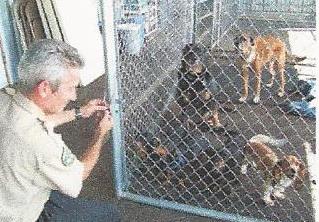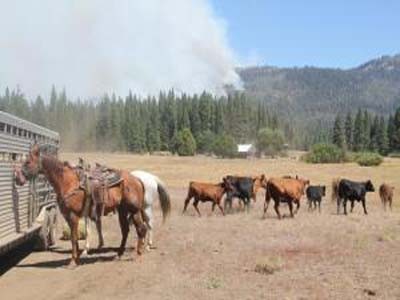Humane Society of Tuolumne County: Disaster Response and Recovery Grant Report
How did this grant help your organization and the pets in your care?
On August, 17, 2013, late afternoon, the HSOTC was alerted by Animal Control, the command center for pet evacuations in Tuolumne County, to prepare to house an influx of animal evacuees from the Rim Fire. The HSOTC staff immediately began moving shelter dogs from two kennels into one, and consolidating cats and kittens to open up space for evacuated canines and felines. Proactively, we reached out to Tractor Supply and Walmart with requests for food to handle the anticipated increased population. By the morning of August 18, 2013, we were ready for intake of animal evacuees and had received a pallet of food from both Tractor Supply and Walmart.
Dogs and cats immediately started arriving at our Shelter. As Animal Control took in evacuees from pet owners and rescuers, they created records on each animal and, once Animal Control kennels were at capacity, they brought animals, along with their records, to our Shelter.
From the time an animal entered our Shelter, Animal Control staff and HSOTC staff worked together to keep each animal’s record updated to ensure their best care.
We anticipated the need to take our three part-time employees to full time status, and hired an additional part-time employee to cover relief shifts. For the duration of the disaster, HSOTC staff, many of our regular volunteers, and new volunteers from the community who arrived at the Shelter wanting to help, worked virtually non-stop disinfecting kennels, cleaning cattery "condos" and litter boxes, walking dogs and making sure animals were safe, sound, and loved. From August 17 - September 4 we were unable to accept any new, non-evacuated, animals into our facility as we were at full capacity with 30 additional evacuated animals. The direct financial impact on our bottom line was in excess of $6,100. All of the animals that were in our care are now back home with their owners.
Per week, under normal circumstances, we have 1 ½ staff per shift for our cattery and 2 ½ staff per shift for our two kennels. The Rim Fire necessitated that our staffing for our cattery be increased to 2 ½ staff per shift and the kennels to 4 ½ staff per shift, plus a part-time relief worker. Given the number of evacuated animals, we had to ramp up the staff hours to compensate for the increased population over and above our normal complement of 40 - 50 animals. The direct impact on our bottom line was as follows:
• Increase staffing costs from part-time to full-time = 3 staff @ $280.00 per week or $840.00 per week. Three weeks = $2520.00
• Increase staffing costs for one part-time, on-call relief worker = 1 staff @ $280.00 per week. Two and one-half weeks = $700.00
• Cost of housing, feeding and cleaning cages for the evacuated cats @ approximately $3.73 per cat, per day = 13 cats @ 3.93 x 7 days = $357.63 per week.* Three weeks = $1072.89
• Cost of housing, feeding, cleaning cages and walking dogs 3 – 5 times per day for the evacuated dogs @ approximately $5.12 per dog, per day = 17 dogs @ 5.12 x 7 days = $609.28 per week.* Three weeks = $1827.84
*Estimates on daily costs for animals are based on food, special needs, utilities, cleaning supplies, water usage and sanitation, garbage, laundry, and are based on hard costs alone and do not reflect the help of numerous volunteers who help offset the need for additional employees.
How many pets did this grant help?
30 animals were sheltered, feed, and cared for over three weeks.
Please provide a story of one or more specific pets this grant helped.
All in all the Humane Society of Tuolumne County and Tuolumne County Animal Control ended up sheltering 59 cats, 36 dogs and two birds. Combined we fielded calls to provide resources for over 180 animals and transported for some owners in difficult circumstances. Evacuated families are under extreme stress and the welfare of their pets is a major concern. The most important thing that all involved with the care of the evacuated animals provided was peace of mind. All of us are thankful for the men and women who fought the fire, which should be fully contained by October 28, 2013, and to everyone in between who showed their community support by helping in any way possible.






